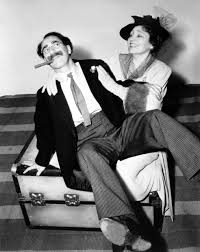Enter now to win a copy of
Straight Lady:
The Life and Times of Margaret Dumont, “The Fifth Marx Brother”

When Margaret Dumont first lent her statuesque dignity to the Marx Brothers’ stage and screen performances, she never anticipated having to wear a special harness to work with them. The Cocoanuts, Animal Crackers, Duck Soup, and A Night at the Opera were successful projects, but she paid a price for her participation in each film. In the ten years plus she’d been costarring with the comedians, she’d suffered with injuries from Groucho jumping on her to get a piggyback ride, bruised calves and shins from Chico trying to sit on her lap while she was standing up and cracked ribs from Harpo who had tackled her to the ground as she exited various scenes. The brothers’ antics had never failed to make audiences laugh, but, consequently, Margaret was often in pain. Her decision to wear a harness around her upper body was to prevent from having her ribs broken. That protection added inches to her frame, and it showed on camera, but she didn’t mind. Margaret’s goal was to be the perfect straight lady no matter the cost.
In 1936, moviegoers could see Margaret in a variety of films from musicals to comedies. A Night at the Opera was playing at theaters everywhere and was being hailed as the “funniest picture ever made.” Margaret’s portrayal of wealthy, dowager Mrs. Claypool provided some of the picture’s most memorable scenes. Her character meets her costars in the film on an ocean liner.
Margaret’s character in Anything Goes, starring Bing Crosby and Ethel Merman, also meets her costars on an ocean liner. The Paramount Pictures musical comedy centers around a young man who falls in love with an English heiress who is being returned home after having run away. The film featured music written and composed by Cole Porter. The Broadway stage show adapted nicely to film and included such songs as “You’re the Tops,” “I Get a Kick Out of You,” and “Anything Goes.”
After appearing in Anything Goes where audiences were serenaded with popular Cole Porter tunes, Margaret costarred in the screen version of George M. Cohan’s stage success Song and Dance Man. The musical drama starred Claire Trevor, Paul Kelly, and Michael Whalen in the title roles. Song and Dance Man is the story of an entertainer whose girlfriend has a chance to make it to the big time if he steps out of the picture. Critics called the film “the greatest story of theatrical life ever written.”
With roots in musical theater, Margaret was grateful to be a part of both Song and Dance Man and Anything Goes, but her contribution was minor, and she longed for more screen time. MGM executives planned to help her realize her ambition. Irving Thalberg wanted to make another Marx Brothers’ picture, and Margaret was essential to the process. Time after time, the winning formula on camera proved to be Groucho, Chico, Harpo, and Margaret Dumont. Thalberg had every confidence he’d strike gold again with the same players.
The overwhelming success of A Night at the Opera had barely been realized when Thalberg hired writers George Seaton and Robert Pirosh to come up with an idea for the next Marx Brothers’ film. The notion of placing the comedy team in the setting of a sanitarium amused the gag and screenwriters, and they were excited to present the concept to Thalberg. He liked the thought and believed the backdrop was ripe with comic potential but felt something was lacking. A solitary setting wouldn’t be enough. When Seaton and Pirosh brought the notion of a racetrack near the health resort, the motion picture executive enthusiastically approved.


